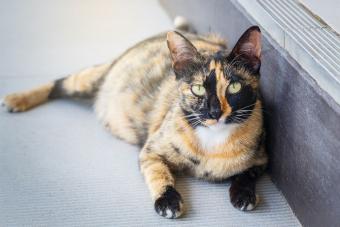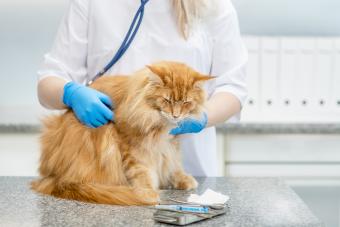
If your feline friend is sneezing or has eye discharge, these cat cold symptoms can indicate a mild viral cold or the beginning a more serious respiratory infection. If caught in the early stages, it's possible you could treat your cat's cold at home. However, concerning signs, such as coughing, labored breathing, or inappetence (lack of appetite), warrant a trip to the vet.
Can Cats Really Get Colds?
When people get colds, it is typically caused by a rhinovirus. Cats are not generally susceptible to the same viruses that affect humans, but they are affected by feline-specific viruses that produce similar symptoms. Nearly all cat "colds" can be traced to an infection by either calicivirus or herpesvirus. Symptoms of illness usually show up anywhere from a few days up to a week after initial exposure from an infected cat or contaminated object.
However, it's possible for your cat to have a cold even if they weren't recently exposed. Feline herpesvirus is estimated to effect over 90 percent of the cat population, and it can remain latent in a cat's body. During times of stress, the virus can become reactivated, which may spur cat cold symptoms.
Common Cat Cold Symptoms
How can you tell when your cat might have a cold? Watch for the following symptoms.
1. Sneezing
Sneezing is an involuntary reflex designed to expel foreign bodies and other invaders from the nasal system. It is typically the first and most prominent cold symptom you'll notice in your cat. Most cats with a cold will sneeze more than just a few times; they'll generally experience persistent sneezing or even sneezing fits.
2. Runny Nose
As the virus begins to cause irritation to the nasal lining, the body produces mucus to protect those passages. As new mucus is produced, the excess leaks from the nostrils or is expelled through sneezing. Your cat's nasal discharge may be clear and aqueous, or it might have a more mucusy appearance.

3. Eye Discharge
Watery eyes are another common symptom of a feline cold, and can occur in one or both eyes. Ocular discharge can build up around the eyes and dry to an uncomfortable crust if not gently wiped away using a clean, moist cloth. It's also possible for cats to develop conjunctivitis, which is inflammation of the eye tissues, as a result of a cold virus. Accompanying symptoms might be squinting, pawing at the eyes, red eyes, or holding the eyes closed.

4. Lethargy
It's not unusual for a cat to feel a little tired while their immune system is engaged in fighting off a viral invader. A cat with a cold may sleep more and will likely be less interested in investigating their environment. It's also possible their lethargy could be due to an increase in internal temperature.
5. Fever
It can be difficult to know just from touching your cat if they have a fever. Their normal body temperature is higher than a human's and somewhere between 100 and 102 degrees Fahrenheit. If you feel comfortable doing so, you can take your cat's temperature using a rectal thermometer or have it taken at your veterinary hospital. Any fever that lasts over 24 hours or rises above 105 degrees should be treated by a vet immediately.

6. Decreased Appetite
Many cats suffering from a cold won't eat as much or as often as they usually do. This could be related to a fever or congestion. When cats have a blocked nose, it is difficult for them to smell their food, and, unfortunately, this loss of scent can affect their appetite. Inflammation in their throat tissues from the cold can also make swallowing uncomfortable.
Symptoms That Suggest Your Cat May Have More Than a Cold
The presence of some symptoms may indicate your cat has more than just a common cold. If you notice the following signs, it's important to seek veterinary care.
- Coughing: Coughing usually indicates the infection has spread to the lungs and developed into pneumonia.
- Labored breathing: Severe upper respiratory infections, where a cat develops blocked nasal passages due to discharge, can lead to open mouth breathing. This is dangerous for cats and should be addressed by a veterinarian. Labored breathing could also point to pneumonia or other life-threatening conditions.
- Dark mucus: It's typical to see a clear or creamy colored mucus discharge in a cat with a cold, but if the mucus begins to turn shades of yellow, green, or brown, it is likely a sign that a secondary bacterial infection has set in, which must be treated with antibiotics.
- Sores: Viral infections can cause uncomfortable ulcers to develop in a cat's mouth or around their nose or eyes. Typically, antibiotics and pain medication are needed for these sores.
- Not eating: A cat should never go more than 24 hours without eating, so a cat who has stopped eating completely as a result of a cold should be seen by a vet.
Treatment for Cat Cold Symptoms
If your cat is still eating and overall acting like themselves, you can try to treat their cold at home. The main treatment for feline cold symptoms is to provide supportive measures to help your cat feel more comfortable as their immune system concentrates on fighting the virus.

- Keep your cat hydrated.
- Wipe away nasal and eye discharge frequently with a clean, wet tissue or towel.
- Help loosen up mucus by creating a steam room; simply run hot water in the shower and bring your cat into the bathroom (supervised) for a few minutes.
- If your cat's appetite is down, make food for appetizing by trying enticing canned diets, warming it up slightly, or adding water to make a tasty gravy.
- Add more humidity to your cat's immediate environment with a cool mist vaporizer.
- Minimize the stress level in your home to allow your cat to heal.
Preventing Colds in Cats
Although there is no way to completely eliminate a cat's chance of getting a cold or upper respiratory infection, you can help prevent this type of illness. One method is to boost their immune system so they are better able to fight off a virus once they have been exposed.
- Make sure your cat is properly vaccinated.
- Providing good nutrition is key to keeping the immune system in top condition. Always feed your cat the best quality food you can afford.
- Limit your cat's exposure to cats outside of the household. If you interact with ill cats at a shelter or friend's house, wash your hands and remove your clothing before playing with your cat.
- If your cat has the herpesvirus, a lysine supplement can help suppress symptoms.
Catch a Cold Early
Daily interactions with your cat will help you spot feline cold symptoms at the earliest opportunity. Early detection can allow you to provide comfort and treatment to an ailing cat. However, if your cat displays any concerning signs, such as coughing or green nasal discharge, do not delay in bringing your cat to the vet.







